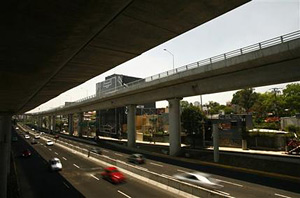 |
 |
 |
 News Around the Republic of Mexico | June 2006 News Around the Republic of Mexico | June 2006  
Mexican Candidates Promise Modernization
 Mark Stevenson - Associated Press Mark Stevenson - Associated Press


| | Cars drive through Mexico City's controversial double-decker expressway on Sunday June 11, 2006. Mexico's presidential candidates are promising to be big spenders, pledging roads, railways and even oil refineries they say will modernize Mexico and attract investment but many fear the candidates' proposals are a throwback to old-style politics, when the government ran up debt and threw together shoddy public-works projects to win over voters. (AP/Dario Lopez-Mills) |
Tepetitan, Mexico - Mexico's presidential candidates are promising to be big spenders, pledging roads, railways and even oil refineries they say will modernize the country and attract investment.

Mexico desperately needs better infrastructure - one group of engineers estimates $330 billion worth. But many fear the candidates' proposals are a throwback to old-style politics, when the government ran up debt and threw together shoddy public-works projects to win over voters.

"A lot of the projects that the candidates are talking about do seem to be white elephants," said Jonathan Heath, chief economist for the Mexico unit of HSBC bank.

Roberto Madrazo, trailing in third place ahead of the July 2 election, sought to revive his campaign this month by announcing plans for an astonishing 1,027 infrastructure and development projects.

Madrazo's Institutional Revolutionary Party ruled Mexico from 1929 to 2000. For most of that era, all-powerful presidents could spend at will, unencumbered by congressional oversight or fiscal discipline.

But leftist Andres Manuel Lopez Obrador has seen those ambitions and raised him a few, including plans for 30 new public universities during his six-year term.

Lopez Obrador wants to build a bullet train from Mexico City to the Texas border. And he plans rail and road links from the Gulf of Mexico to the Pacific to rival the Panama Canal, and highways where there are now only goat paths.

As Mexico City mayor from 2000-2005, Lopez Obrador built miles of double-decker expressways and a free city university.

But the expressways have created their own traffic snarls, and many question the value of the university, which has no entrance exam, gives no grades, and whose 11 degree programs lean heavily toward the social sciences and community activism.

Lopez Obrador's main rival, Felipe Calderon of the ruling National Action Party, isn't sitting this competition out.

He is pledging to crisscross Mexico with new roads and build water treatment and distribution systems - less visible but sorely needed projects.

Calderon and Lopez Obrador are running nearly even, according to most polls.

To some extent, it's traditional politicking.

"Voters do want to see public works," political analyst Federico Estevez said.

But voters aren't the only ones who want to see big public-works projects. Carlos Slim, a Mexican telecommunications magnate and the world's third-richest man, has launched a construction and infrastructure investment company and is pressing the candidates to commit to dozens of new building projects.

Some argue that Slim, whose fortune is estimated at around $30 billion, would profit from the candidates' proposals.

But Slim and others say low interest rates, economic stability and high foreign reserves represent a golden opportunity for Mexico to make a great leap forward.

"What really would be important for Mexico is to break the barrier of underdevelopment, and we are not far from breaking it," Slim said recently.

In the 1970s, high oil prices produced soaring buildings and mammoth industrialization projects that fueled the development of entire manufacturing towns.

Lopez Obrador and Madrazo seem marked by that era. Both began their political careers in the 1970s, and both are from the oil-producing Gulf coast state of Tabasco, where the landscape is dominated by two things: swamps and big government projects.

In his first big government job, as director of Tabasco's Indian development agency, Lopez Obrador created subsistence farming plots for landless Indians by scooping soil out of lagoons and piling the dirt into narrow, artificial fingers of land.

"It's classic for swampland politicians. You get a lot of mileage by draining the swamps, like Florida politicians 80 years ago," Estevez said.

Many of the artificial plots now stand abandoned, but the government-funded construction boom continues - notably in Tepetitan, Lopez Obrador's hometown. The current local government, headed by his brother, Jose Ramiro, built a large concrete bridge that leads to nearly impassable dirt roads.

History has not been kind to government projects. By the 1980s, Mexico's oil boom had ended, and the country woke up to a hangover of debt and the realization that many projects had been badly planned and poorly executed.

But candidates in the presidential race vow not to repeat that mistake. Lopez Obrador says he will fund his building spree by reducing waste and high salaries in government. Calderon touts private investment.

Many voters complain that President Vicente Fox, known for his conservative fiscal policy, didn't do enough to create jobs or improve infrastructure.

"I think (Lopez Obrador) sees it as a way of promoting employment, and as long as there are big projects in his term, he's created jobs," Heath said.

He noted another incentive: "At the end of the term, there's a big plaque with his name on it." | 
 | |
 |



